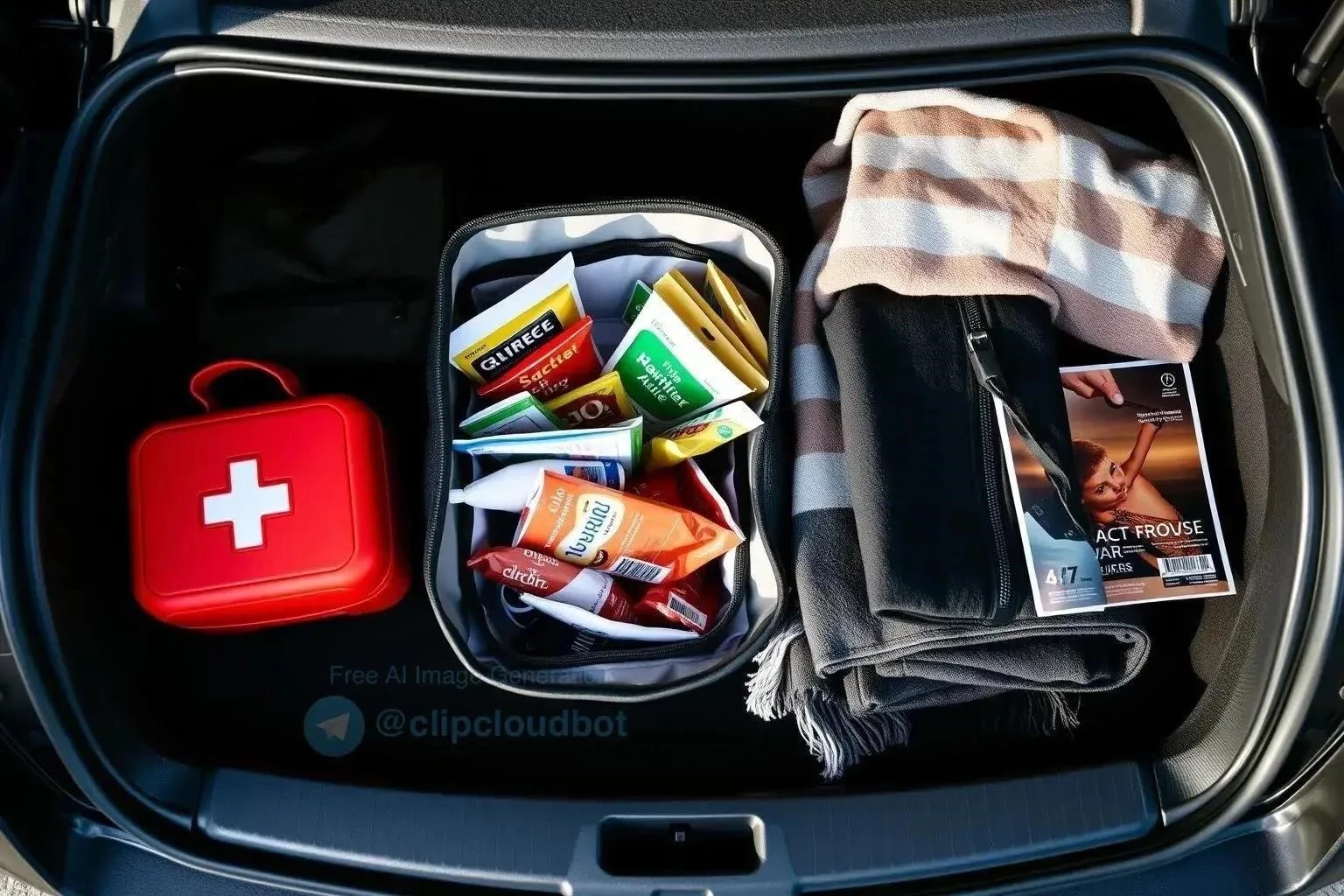Embarking on a car journey offers unparalleled freedom and the opportunity to explore at your own pace․ However, a successful road trip requires careful planning and preparation․ From ensuring your vehicle is in top condition to packing the right essentials, a little forethought can make all the difference between a memorable adventure and a stressful ordeal․ This guide outlines four key areas to focus on before hitting the open road, ensuring a safe and enjoyable travel experience․ Let’s dive into the essentials for traveling by car․
1․ Vehicle Preparation: Ensuring Car Travel Safety
Before you even think about packing your bags, prioritize your vehicle’s health․ A well-maintained car is crucial for a safe and trouble-free journey․ This includes a thorough inspection and necessary maintenance․
- Check Fluid Levels: Oil, coolant, brake fluid, power steering fluid, and windshield washer fluid․ Top them off as needed․
- Inspect Tires: Check tire pressure (including the spare!), tread depth, and for any signs of damage․
- Brakes: Ensure your brakes are functioning properly․ Listen for any unusual noises and have them inspected by a mechanic if necessary․
- Lights: Verify that all headlights, taillights, brake lights, and turn signals are working․
- Battery: Check the battery terminals for corrosion and ensure the battery is securely mounted․
Essential Car Travel Maintenance Checklist
Consider taking your car for a professional tune-up before a long trip․ This can identify potential problems before they become major issues on the road․
Factoid: Regular car maintenance not only ensures a safer trip but can also improve fuel efficiency, saving you money on gas․
2․ Packing Smart: Car Travel Comfort and Convenience
Packing efficiently is key to a comfortable and organized car trip․ Think about what you’ll need access to during the drive versus what can be stored in the trunk․
- Navigation: GPS device or smartphone with a reliable navigation app․ Download offline maps in case you lose cell service․
- Emergency Kit: Jumper cables, first-aid kit, flashlight, warning flares, multi-tool, and a blanket․
- Snacks and Drinks: Pack healthy snacks and plenty of water to avoid unhealthy fast-food stops․
- Entertainment: Books, music, podcasts, or audiobooks to keep everyone entertained during long stretches of driving․
- Comfort Items: Pillows, blankets, and comfortable clothing for a more relaxing ride․
3․ Route Planning: Optimizing Car Travel Itinerary
Careful route planning can save you time, money, and stress․ Consider factors like traffic, road conditions, and points of interest along the way․
- Choose Your Route: Use online mapping tools to plan your route and identify potential detours or construction zones․
- Estimate Travel Time: Factor in rest stops, meal breaks, and potential delays․
- Identify Points of Interest: Research attractions, restaurants, and scenic overlooks along your route․
- Book Accommodations: If you’re planning an overnight trip, book your accommodations in advance, especially during peak season․
4․ Safety First: Prioritizing Car Travel Security
Safety should always be your top priority when traveling by car․ This includes practicing safe driving habits and being prepared for emergencies․
- Safe Driving Habits: Avoid distractions, obey traffic laws, and take frequent breaks to avoid fatigue․
- Emergency Contacts: Keep a list of emergency contacts readily available․
- Share Your Itinerary: Let someone know your route and estimated arrival time․
- Stay Alert: Be aware of your surroundings and report any suspicious activity․
FAQ: Car Travel Questions Answered
What should I do if my car breaks down on the road?
Pull over to a safe location, turn on your hazard lights, and call for roadside assistance․ If you have a cell phone, use it to call for help․ If not, use a roadside assistance call box․
How often should I take breaks when driving long distances?
It’s recommended to take a break every two hours to stretch your legs, get some fresh air, and avoid fatigue․
What are some essential items to pack in my car’s emergency kit?
Jumper cables, a first-aid kit, a flashlight, warning flares, a multi-tool, and a blanket are all essential items for a car emergency kit․
How can I save money on gas during a road trip?
Drive at a steady speed, avoid excessive acceleration and braking, and keep your tires properly inflated․ Also, consider using a gas price app to find the cheapest gas stations along your route․
What documents should I carry with me on a car trip?
Ensure you have your driver’s license, vehicle registration, and proof of insurance readily accessible․ If traveling internationally, carry your passport and any necessary visas;
Advanced Car Travel Considerations: Beyond the Basics
While the aforementioned essentials provide a solid foundation for a successful car journey, several advanced considerations can further enhance the experience and mitigate potential risks․ These encompass aspects of technological integration, environmental awareness, and proactive contingency planning․
Technological Integration for Enhanced Car Travel
Modern technology offers a plethora of tools to optimize car travel; Beyond basic navigation, consider utilizing applications that provide real-time traffic updates, fuel price comparisons, and access to roadside assistance services․ Furthermore, investing in a dashcam can provide valuable evidence in the event of an accident, while a portable Wi-Fi hotspot can ensure consistent internet connectivity for passengers․
Environmental Awareness and Responsible Car Travel
Conscious environmental stewardship is paramount, even during recreational travel․ Minimize your carbon footprint by ensuring your vehicle is properly maintained and operating efficiently․ Consider utilizing cruise control to maintain a consistent speed and reduce fuel consumption․ Furthermore, dispose of waste responsibly and support local businesses that prioritize sustainable practices․
Factoid: Idling your car for more than 10 seconds wastes more fuel and produces more emissions than restarting the engine․
Proactive Contingency Planning for Unforeseen Circumstances
Despite meticulous planning, unforeseen circumstances can arise during car travel․ Develop a comprehensive contingency plan that addresses potential scenarios such as inclement weather, unexpected road closures, or mechanical failures․ This plan should include alternative routes, emergency contact information, and a strategy for securing temporary accommodation if necessary․ Consider investing in a roadside assistance plan that provides comprehensive coverage for a range of potential issues․
Traveling by car offers a unique blend of freedom and adventure․ By meticulously preparing your vehicle, packing strategically, planning your route thoughtfully, and prioritizing safety, you can transform a potentially stressful experience into a memorable and rewarding journey․ Embrace the open road with confidence, knowing that you have taken the necessary steps to ensure a smooth, safe, and enjoyable travel experience․ Remember that proactive planning and a commitment to responsible travel practices are the cornerstones of a successful car adventure․
Traveling by car offers a unique blend of freedom and adventure․ By meticulously preparing your vehicle, packing strategically, planning your route thoughtfully, and prioritizing safety, you can transform a potentially stressful experience into a memorable and rewarding journey․ Embrace the open road with confidence, knowing that you have taken the necessary steps to ensure a smooth, safe, and enjoyable travel experience․ Remember that proactive planning and a commitment to responsible travel practices are the cornerstones of a successful car adventure․
Navigating the Nuances of International Car Travel
For those venturing beyond national borders, car travel necessitates a heightened level of preparation and awareness․ International driving presents a unique set of challenges, ranging from differing traffic laws and road signage to varying fuel standards and insurance requirements․ A comprehensive understanding of these nuances is paramount to ensuring a seamless and legally compliant journey․
Acquiring Essential Documentation for Cross-Border Car Travel
Prior to embarking on an international car trip, meticulous attention must be paid to acquiring the necessary documentation․ This typically includes a valid passport, a driver’s license recognized in the destination country (potentially requiring an International Driving Permit), vehicle registration documents, and proof of adequate insurance coverage․ Furthermore, it is prudent to research any specific visa requirements or customs regulations that may apply to the countries being traversed․
Understanding and Adhering to Foreign Traffic Laws
Traffic laws and regulations vary significantly across international borders․ Familiarizing oneself with the specific rules of the road in each destination country is crucial for avoiding fines, penalties, and potential accidents․ This includes understanding speed limits, right-of-way rules, parking regulations, and any specific requirements regarding vehicle equipment, such as mandatory reflective vests or warning triangles․
Addressing Vehicle Maintenance and Fuel Considerations Abroad
Maintaining the vehicle’s operational integrity is of paramount importance during international car travel․ Before departure, a thorough inspection should be conducted to ensure that all essential systems are functioning optimally․ Furthermore, it is advisable to research the availability and compatibility of fuel types in the destination countries, as fuel standards may differ from those in the country of origin․ Carrying essential spare parts and tools can also prove invaluable in the event of minor mechanical issues․
Insurance and Emergency Preparedness in Foreign Lands
Adequate insurance coverage is an indispensable component of international car travel․ Ensure that your insurance policy provides sufficient coverage for potential accidents, theft, or damage to the vehicle while abroad․ Furthermore, it is prudent to familiarize oneself with local emergency contact numbers and procedures, as well as to carry a comprehensive first-aid kit and any necessary medications․
The Future of Car Travel: Emerging Trends and Technologies
The landscape of car travel is undergoing a period of rapid transformation, driven by technological advancements and evolving consumer preferences․ From the proliferation of electric vehicles to the development of autonomous driving systems, the future of car travel promises to be significantly different from its present iteration․ Understanding these emerging trends is essential for anticipating the challenges and opportunities that lie ahead․
The Rise of Electric Vehicles and Sustainable Car Travel
Electric vehicles (EVs) are rapidly gaining traction as a viable alternative to traditional gasoline-powered cars․ The increasing availability of charging infrastructure, coupled with government incentives and growing environmental awareness, is driving the adoption of EVs for both short-distance commutes and long-distance travel․ As battery technology continues to improve, the range and performance of EVs will further enhance their appeal for car travel enthusiasts․
The Advent of Autonomous Driving Systems
Autonomous driving technology holds the potential to revolutionize the car travel experience․ Self-driving cars promise to enhance safety, reduce traffic congestion, and free up drivers to engage in other activities while on the road․ While fully autonomous vehicles are not yet widely available, advanced driver-assistance systems (ADAS) are becoming increasingly prevalent, offering features such as adaptive cruise control, lane-keeping assist, and automatic emergency braking․
Connectivity and the Internet of Things in Car Travel
The integration of connectivity and the Internet of Things (IoT) is transforming the car into a mobile hub of information and entertainment․ Connected car technologies enable access to real-time traffic updates, weather forecasts, and navigation services, as well as providing seamless integration with smartphones and other devices․ Furthermore, IoT-enabled sensors and systems can monitor vehicle performance, predict maintenance needs, and enhance overall safety and efficiency․
Factoid: The average car contains over 30,000 parts, many of which are now monitored by sensors connected to the Internet of Things․


